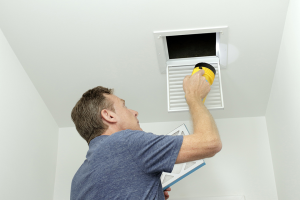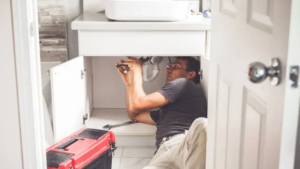Plumbers install and repair the pipes that supply water and carry waste away from homes and businesses. They also inspect these systems and ensure they meet building codes.
They may collaborate with architects and construction teams to design plumbing systems for new buildings. They also provide emergency services for burst pipes and clogged drains. Contact Gateway Plumbers of Aurora now!

As a plumber, you’ll work on projects that involve laying pipes and tying in water and other utilities. This could include installing toilets, faucets and kitchen appliances. In addition, plumbing jobs often include repairing existing systems. This requires strong problem-solving skills, and you’ll also need to understand how to read blueprints and technical drawings.
Plumbers are typically responsible for preparing the site for pipe installation and working with contractors to ensure all the necessary construction is completed according to plan. They also assist with the inspection and testing of plumbing equipment to determine the cause of problems or malfunctions. This can be done with a variety of tools, including electronic testers and calibrated measuring devices.
In some cases, you may need to be able to communicate with customers about their plumbing needs and provide them with helpful information about how to avoid common issues in the future. This is why it’s important for plumbers to have excellent customer service skills and be able to handle a range of situations.
As the job of a plumber involves a lot of manual labor, it’s crucial to have enough physical strength and stamina to perform all of your duties. You’ll need to be able to carry heavy objects and spend long periods of time on your feet. You’ll also need to be able to maneuver in tight spaces with limited visibility.
Asking candidates about their previous plumbing experience allows you to gauge their level of comfort and expertise with the necessary tasks of the job. It’s also a good idea to ask about their career aspirations, as this will help you assess whether or not their professional goals align with your company’s vision.
Plumbers are required to be knowledgeable about local building codes, regulations and standards for plumbing systems. This is particularly important when working on new construction, where plumbers will be required to design and lay out the plumbing infrastructure of a building from the ground up. This will require them to be able to read and interpret blueprints, technical drawings and diagrams.
Education and Training Requirements
There are a few different ways to get the training you need to become a plumber in New York. You can choose to enroll in a formal training program, apprentice with a seasoned plumber or complete a college degree program related to the field. You can also earn professional certifications to enhance your credentials and make you more attractive to employers or clients. These certifications are typically not required, but they can help you stand out from other plumbers.
Many schools in New York offer courses specifically related to plumbing. These courses can give you a better understanding of the technical aspects of the job and prepare you for the state licensing exam. You can find these courses at local community colleges, trade schools and through professional organizations.
A popular way to obtain the skills and experience needed to become a plumber is to attend a formal apprenticeship. In New York, there are several union programs that provide structured apprenticeship opportunities. These programs can last for five years and provide extensive on-the-job training. Some of these apprenticeships are even federally approved and adhere to specific standards, such as those set by the United Association Local 22 in Ithaca, NY.
Regardless of the apprenticeship program you participate in, it is crucial to ensure that it meets all of the requirements in your jurisdiction. In addition to the on-the-job training, most apprenticeships include classroom instruction focusing on OSHA safety standards and detailed information about chemistry, math and physics. You will also be trained on how to read blueprints and learn about different types of plumbing fixtures and appliances.
Once you have completed your apprenticeship and passed the state licensing exam, you can start working as a journey plumber in New York. Depending on the jurisdiction, you may be required to work as a journey plumber for several more years before you can apply for a master plumber license.
In addition to the state licensing requirements, some municipalities require that you take continuing education courses to renew your license. For example, in New York City, master plumbers must take seven hours of continuing education to renew their license.
Salary
Plumbers typically make a decent living and can be quite satisfied with their careers. The average salary, however, varies depending on several factors including geographic location and years of experience. For example, the average plumber salary in California is higher than that of Florida. In addition, senior plumbers typically earn more than their entry-level counterparts.
There are also a few ways to increase your salary as a plumber, such as earning certifications or participating in additional training courses. These steps not only help you become a more valuable worker, but they can also give you a leg up when applying for jobs.
Another way to boost your paycheck is to become a certified plumbing inspector. These individuals examine and test plumbing systems to ensure that they comply with state and local building codes. They may also be asked to provide information and instructions to property or business owners on how to fix specific code violations. This is a great career option for plumbers who are interested in working on large-scale construction projects.
Some plumbers specialize in certain types of work, which can also lead to a higher pay grade. For instance, a plumber who is experienced in installing fire suppression systems or drainage networks can command a higher salary than one who specializes in residential plumbing projects.
If you have a knack for inspiring and leading others, consider becoming a plumbing foreman. In this role, you oversee a team of plumbers and are responsible for scheduling and completing jobs. You also have the opportunity to set your own wages, which can be beneficial if you’re looking for a lucrative full-time career in plumbing.
If you’re considering a career as a plumber, it’s important to research the various job opportunities in your area and choose the right position for you. Taking the time to do your research will help you find the best salary for a plumber in your area and will ensure that you’re getting the most out of your potential.
Work Environment
Plumbers work with a wide range of tools and equipment. They use their knowledge of building codes and blueprints to install piping, fixtures, and appliances such as sinks, toilets, showers, water heaters, and irrigation systems. They also troubleshoot issues such as leaks and clogs. Additionally, they may collaborate with architects and construction teams to ensure plumbing systems integrate seamlessly into new building projects.
A career as a plumber is challenging but rewarding. Plumbers often work a flexible schedule and must be on-call for emergency jobs, such as when someone’s kitchen pipes burst at 5 a.m. Plumbers must also be comfortable working in confined spaces and on elevated surfaces.
In addition, plumbers must be able to identify problems quickly and solve them effectively. This requires critical thinking skills, as well as the ability to weigh options and explain them to customers. They must also have physical strength to lift heavy tools and equipment. Plumbers can choose to work in residential, commercial, or industrial environments, depending on their specialties and the types of piping they install.
Most states require plumbers to be licensed in order to work on certain types of plumbing systems. In New York, for example, the licensing process is overseen by the City Department of Buildings. The license process is typically a combination of education, experience, and an exam.
Employers can increase their chances of hiring qualified plumbers by creating a positive company culture and making the job more attractive to potential applicants. This can be done by highlighting the benefits of working for the company, such as a flexible work environment and opportunities for advancement. It’s also important to advertise the job correctly, using online and offline channels. Finally, consider hosting a recruiting event at your company to meet with potential candidates and showcase the role’s duties and responsibilities.



